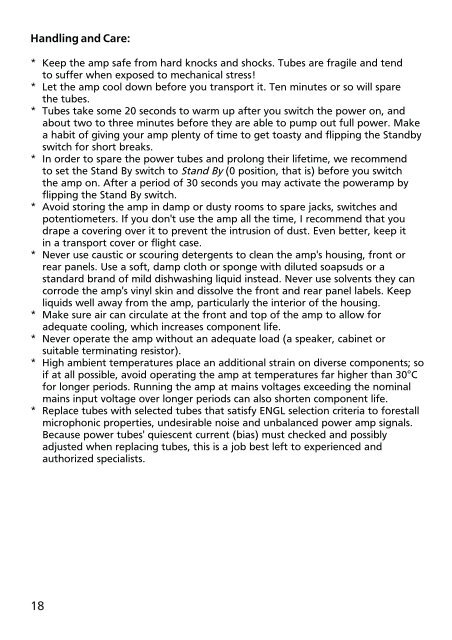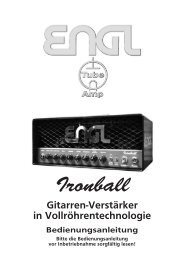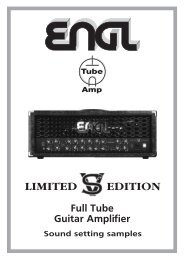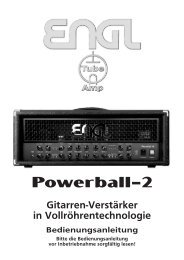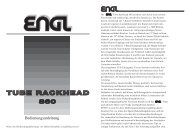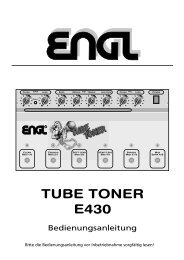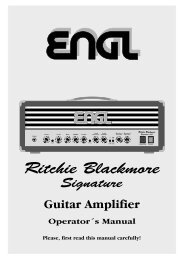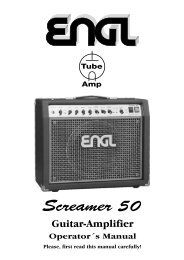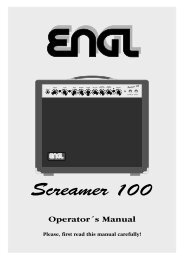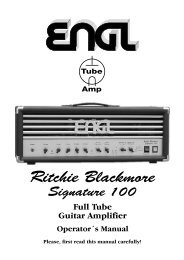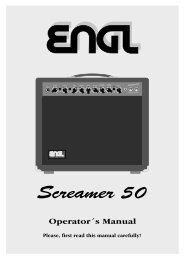LIMITED EDITION - Engl
LIMITED EDITION - Engl
LIMITED EDITION - Engl
Create successful ePaper yourself
Turn your PDF publications into a flip-book with our unique Google optimized e-Paper software.
Handling and Care:<br />
* Keep the amp safe from hard knocks and shocks. Tubes are fragile and tend<br />
to suffer when exposed to mechanical stress!<br />
* Let the amp cool down before you transport it. Ten minutes or so will spare<br />
the tubes.<br />
* Tubes take some 20 seconds to warm up after you switch the power on, and<br />
about two to three minutes before they are able to pump out full power. Make<br />
a habit of giving your amp plenty of time to get toasty and flipping the Standby<br />
switch for short breaks.<br />
* In order to spare the power tubes and prolong their lifetime, we recommend<br />
to set the Stand By switch to Stand By (0 position, that is) before you switch<br />
the amp on. After a period of 30 seconds you may activate the poweramp by<br />
flipping the Stand By switch.<br />
* Avoid storing the amp in damp or dusty rooms to spare jacks, switches and<br />
potentiometers. If you don't use the amp all the time, I recommend that you<br />
drape a covering over it to prevent the intrusion of dust. Even better, keep it<br />
in a transport cover or flight case.<br />
* Never use caustic or scouring detergents to clean the amp's housing, front or<br />
rear panels. Use a soft, damp cloth or sponge with diluted soapsuds or a<br />
standard brand of mild dishwashing liquid instead. Never use solvents they can<br />
corrode the amp's vinyl skin and dissolve the front and rear panel labels. Keep<br />
liquids well away from the amp, particularly the interior of the housing.<br />
* Make sure air can circulate at the front and top of the amp to allow for<br />
adequate cooling, which increases component life.<br />
* Never operate the amp without an adequate load (a speaker, cabinet or<br />
suitable terminating resistor).<br />
* High ambient temperatures place an additional strain on diverse components; so<br />
if at all possible, avoid operating the amp at temperatures far higher than 30°C<br />
for longer periods. Running the amp at mains voltages exceeding the nominal<br />
mains input voltage over longer periods can also shorten component life.<br />
* Replace tubes with selected tubes that satisfy ENGL selection criteria to forestall<br />
microphonic properties, undesirable noise and unbalanced power amp signals.<br />
Because power tubes' quiescent current (bias) must checked and possibly<br />
adjusted when replacing tubes, this is a job best left to experienced and<br />
authorized specialists.<br />
18


